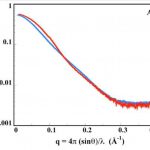Lien vers Pubmed [PMID] – 26374675
Lien DOI – 10.1038/srep14223
Sci Rep 2015 Sep; 5(): 14223
Many Gram-negative bacteria use Type I secretion systems, T1SS, to secrete virulence factors that contain calcium-binding Repeat-in-ToXin (RTX) motifs. Here, we present structural models of an RTX protein, RD, in both its intrinsically disordered calcium-free Apo-state and its folded calcium-bound Holo-state. Apo-RD behaves as a disordered polymer chain comprising several statistical elements that exhibit local rigidity with residual secondary structure. Holo-RD is a folded multi-domain protein with an anisometric shape. RTX motifs thus appear remarkably adapted to the structural and mechanistic constraints of the secretion process. In the low calcium environment of the bacterial cytosol, Apo-RD is an elongated disordered coil appropriately sized for transport through the narrow secretion machinery. The progressive folding of Holo-RD in the extracellular calcium-rich environment as it emerges form the T1SS may then favor its unidirectional export through the secretory channel. This process is relevant for hundreds of bacterial species producing virulent RTX proteins.













